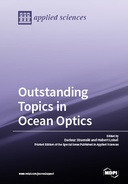Explore

Outstanding Topics in Ocean Optics
Dariusz Stramski and Hubert Loisel
2019
0 Ungluers have
Faved this Work
Login to Fave
Ocean optics is a branch of oceanography which is firmly embedded in studies of a great variety of ocean science and engineering questions. The interactive nature between radiative transfer of light and various dissolved and particulate constituents of seawater is at the core of ocean optics science and applications. The transfer of radiant solar energy has vital implications to life and climate on Earth, and the large variety of subjects of ocean optics ranges from the subtle problems of physical optics to optical remote sensing towards a better understanding of ocean biology, biogeochemistry and ecosystems and their roles in the Earth's system processes. The intention of this book is to present a collection of papers that generally share a common denominator of frontier topics in ocean optics which are unique, uncommon or outstanding in the literature, and to provide a balanced view of the extraordinary breadth of research in this field. Topics as diverse as measurements and modeling of radiative transfer, light fields, light scattering and polarization, ocean color, benthic optical properties, and the use of optics for characterizing seawater constituents are addressed in this book. The book is expected to be of interest and useful to a broad audience of professional ocean scientists, engineers and advanced students with an interest in ocean optics and applications of optical methods in oceanography.
This book is included in DOAB.
Why read this book? Have your say.
You must be logged in to comment.
Rights Information
Are you the author or publisher of this work? If so, you can claim it as yours by registering as an Unglue.it rights holder.Downloads
This work has been downloaded 335 times via unglue.it ebook links.
- 114 - pdf (CC BY-NC-ND) at Unglue.it.
- 192 - pdf (CC BY-NC-ND) at res.mdpi.com.
Keywords
- 3D Monte Carlo numerical simulations
- algorithm development
- anomalous properties of water
- apparent optical properties
- Atmosphere
- backscattering ratio
- bathymetry
- bottom mapping
- bulk refractive index
- canopy
- CDOM
- CDOM and ENSO
- CDOM climatology
- CDOM spectral slope
- chlorophyll-a
- chromophoric dissolved organic matter
- coated-sphere model
- coral
- coral reef
- coupled systems
- degree of linear polarization
- derivative
- dissolved organic carbon
- DOM
- downward irradiance
- EEMS
- FDOM
- FerryBox
- forward modeling
- fractal structure
- Gelbstoff
- Gershun equation
- global oceans
- hyperspectral
- inelastic processes
- inherent optical properties
- inverse problems
- irradiance quartet
- Kallemeter
- light scattering
- light scattering by pure seawater
- light scattering by pure water
- light scattering measurements
- LISST-VSF instrument
- Machine learning
- marine optics
- marine particles
- marine sensors
- melt ponds
- MERIS
- Mueller matrix
- NASA PACE mission
- natural organic matter
- Norway
- Ocean
- ocean color
- ocean color algorithm validation
- ocean color database
- ocean color remote sensing
- ocean colour
- ocean euphotic zone
- ocean optics
- oceanic carbon
- oceanic light field
- optical modelling
- Optical properties
- organic carbon
- PARAFAC
- particle dynamics
- PFT
- Phytoplankton
- phytoplankton pigments
- Polarization
- Radiative Transfer
- radiative transfer approximation
- Remote sensing
- remote-sensing reflectance
- retrieval uncertainty
- satellite radiometry
- sea ice heterogeneity
- seawater component
- sensor noise
- shallow water
- suspended matter
- suspended sediment
- Trondheimsfjord
- upward radiance
- upwelling radiance distribution
- vector radiative transfer
- vertical attenuation coefficient
- volume and surface integral methods
- volume scattering function
Links
DOI: 10.3390/books978-3-03897-705-6Editions


